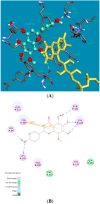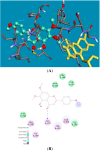Flavonoids from Sideritis Species: Human Monoamine Oxidase (hMAO) Inhibitory Activities, Molecular Docking Studies and Crystal Structure of Xanthomicrol
- PMID: 25915461
- PMCID: PMC6272178
- DOI: 10.3390/molecules20057454
Flavonoids from Sideritis Species: Human Monoamine Oxidase (hMAO) Inhibitory Activities, Molecular Docking Studies and Crystal Structure of Xanthomicrol
Abstract
The inhibitory effects of flavonoids on monoamine oxidases (MAOs) have attracted great interest since alterations in monoaminergic transmission are reported to be related to neurodegenerative diseases such as Parkinson's and Alzheimer's diseases and psychiatric disorders such as depression and anxiety, thus MAOs may be considered as targets for the treatment of these multi-factorial diseases. In the present study, four Sideritis flavonoids, xanthomicrol (1), isoscutellarein 7-O-[6'''-O-acetyl-β-D-allopyranosyl-(1→2)]-β-D-glucopyranoside (2), isoscutellarein 7-O-[6'''-O-acetyl-β-D-allopyranosyl-(1→2)]-6''-O-acetyl-β-D-glucopyranoside (3) and salvigenin (4) were docked computationally into the active site of the human monoamine oxidase isoforms (hMAO-A and hMAO-B) and were also investigated for their hMAO inhibitory potencies using recombinant hMAO isoenzymes. The flavonoids inhibited hMAO-A selectively and reversibly in a competitive mode. Salvigenin (4) was found to be the most potent hMAO-A inhibitor, while xanthomicrol (1) appeared as the most selective hMAO-A inhibitor. The computationally obtained results were in good agreement with the corresponding experimental values. In addition, the x-ray structure of xanthomicrol (1) has been shown. The current work warrants further preclinical studies to assess the potential of xanthomicrol (1) and salvigenin (4) as new selective and reversible hMAO-A inhibitors for the treatment of depression and anxiety.
Conflict of interest statement
The authors declare no conflict of interest.
Figures









Similar articles
-
Quercetin and Related Chromenone Derivatives as Monoamine Oxidase Inhibitors: Targeting Neurological and Mental Disorders.Molecules. 2019 Jan 24;24(3):418. doi: 10.3390/molecules24030418. Molecules. 2019. PMID: 30678358 Free PMC article. Review.
-
Synthesis of some novel hydrazone and 2-pyrazoline derivatives: monoamine oxidase inhibitory activities and docking studies.Bioorg Med Chem Lett. 2014 Aug 1;24(15):3278-84. doi: 10.1016/j.bmcl.2014.06.015. Epub 2014 Jun 17. Bioorg Med Chem Lett. 2014. PMID: 24986657
-
The Benzopyrone Biochanin-A as a reversible, competitive, and selective monoamine oxidase B inhibitor.BMC Complement Altern Med. 2017 Jan 10;17(1):34. doi: 10.1186/s12906-016-1525-y. BMC Complement Altern Med. 2017. PMID: 28069007 Free PMC article.
-
Chalcones: a valid scaffold for monoamine oxidases inhibitors.J Med Chem. 2009 May 14;52(9):2818-24. doi: 10.1021/jm801590u. J Med Chem. 2009. PMID: 19378991
-
Structural Exploration of Synthetic Chromones as Selective MAO-B Inhibitors: A Mini Review.Comb Chem High Throughput Screen. 2017;20(6):522-532. doi: 10.2174/1386207320666170227155517. Comb Chem High Throughput Screen. 2017. PMID: 28245770 Review.
Cited by
-
Repeated administration of a flavonoid-based formulated extract from citrus peels significantly reduces peripheral inflammation-induced pain in the rat.Food Sci Nutr. 2020 May 20;8(7):3173-3180. doi: 10.1002/fsn3.1566. eCollection 2020 Jul. Food Sci Nutr. 2020. PMID: 32724582 Free PMC article.
-
Quercetin and Related Chromenone Derivatives as Monoamine Oxidase Inhibitors: Targeting Neurological and Mental Disorders.Molecules. 2019 Jan 24;24(3):418. doi: 10.3390/molecules24030418. Molecules. 2019. PMID: 30678358 Free PMC article. Review.
-
Computational Studies Applied to Flavonoids against Alzheimer's and Parkinson's Diseases.Oxid Med Cell Longev. 2018 Dec 30;2018:7912765. doi: 10.1155/2018/7912765. eCollection 2018. Oxid Med Cell Longev. 2018. PMID: 30693065 Free PMC article.
-
Natural Products Inhibitors of Monoamine Oxidases-Potential New Drug Leads for Neuroprotection, Neurological Disorders, and Neuroblastoma.Molecules. 2022 Jul 4;27(13):4297. doi: 10.3390/molecules27134297. Molecules. 2022. PMID: 35807542 Free PMC article. Review.
-
3D-QSAR and in-silico Studies of Natural Products and Related Derivatives as Monoamine Oxidase Inhibitors.Curr Neuropharmacol. 2018;16(6):881-900. doi: 10.2174/1570159X15666171128143650. Curr Neuropharmacol. 2018. PMID: 29189167 Free PMC article.
References
-
- Obon de Castro C., Rivera-Nunez D. Phanerogamarum Monographiae Tomus XXI: A Taxonomic Revision of the Section Sideritis (genus Sideritis) (Labiatae) J. Cramer; Berlin, Germany: 1994.
-
- Ezer N., Akcoş Y. Flavonoids from Sideritis lycia. J. Hacettepe Univ. Fac. Pharm. 1995;15:81–87.
-
- Gonzalez-Burgos E., Carretero M.E., Gomez-Serranillos M.P. Sideritis spp.: Uses, chemical composition and pharmacological activities-a review. J. Ethnopharmacol. 1996;135:209–225. - PubMed
Publication types
MeSH terms
Substances
LinkOut - more resources
Full Text Sources
Other Literature Sources

